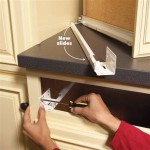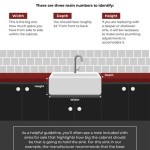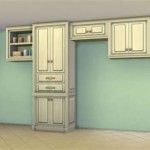How To Clean White Kitchen Cabinets: A Comprehensive Guide
White kitchen cabinets offer a bright, clean aesthetic to any kitchen. However, this pristine look can quickly become marred by grease, grime, food splatters, and dust. Consistent and proper cleaning is crucial to maintaining the beauty and longevity of white kitchen cabinetry. This article provides a detailed guide on how to effectively clean white kitchen cabinets, covering essential tools, appropriate cleaning solutions, and various techniques to tackle different types of stains and build-up.
Before embarking on any cleaning process, it is important to identify the type of material comprising the cabinets. Common materials include painted wood, laminate, and thermofoil. Each material reacts differently to cleaning agents, and using the wrong product can cause damage, discoloration, or peeling. Understanding the cabinet material is the first step in ensuring a safe and effective cleaning process.
Gathering the necessary supplies is essential for efficient cleaning. The following items should be readily available:
- Soft cloths or microfiber towels: Microfiber cloths are preferred because they are gentle on surfaces and effectively trap dirt and grime.
- Non-abrasive sponges: Avoid using scouring pads or steel wool, as these can scratch and damage the cabinet finish.
- Dish soap: A mild dish soap is a versatile and effective cleaning agent for most kitchen cabinet materials.
- Warm water: Warm water helps to dissolve grease and loosen dirt.
- Baking soda: Baking soda is a mild abrasive that can be used to tackle stubborn stains.
- White vinegar: White vinegar is a natural degreaser and disinfectant.
- Spray bottle: A spray bottle is useful for applying cleaning solutions evenly.
- Soft-bristled brush (optional): A soft-bristled brush can be used to reach tight corners and crevices.
- Clean, dry towels: For drying the cabinets after cleaning.
- Protective gloves: To protect hands from cleaning solutions and potential irritants.
Prior to applying any cleaning solution to the entire cabinet surface, it is prudent to test it on an inconspicuous area, such as the inside of a cabinet door or a bottom corner. This will help determine if the solution causes any adverse reactions, such as discoloration or damage to the finish. Allow the test area to dry completely before proceeding with the full cleaning process.
Regular Cleaning with Mild Soap and Water
The most effective way to keep white kitchen cabinets clean is through regular maintenance. A simple mixture of mild dish soap and warm water is often sufficient for removing everyday dirt and grime. This method is gentle enough for most cabinet materials and can be used frequently without causing damage. The frequency of cleaning depends on usage, but wiping down cabinets at least once a week is recommended.
To prepare the cleaning solution, add a small amount of mild dish soap to a bowl of warm water. Stir gently to create suds. Avoid using too much soap, as it can leave a residue on the cabinets. Dip a soft cloth or microfiber towel into the soapy water, wring out the excess, and gently wipe down the cabinet surfaces. Pay particular attention to areas that are prone to grease and splatters, such as around the stove and sink.
After wiping the cabinets with the soapy water solution, use a clean, damp cloth to rinse away any soap residue. It is important to remove all traces of soap, as it can attract dirt and grime over time. Finally, use a clean, dry towel to thoroughly dry the cabinets. This will prevent water spots and ensure a streak-free finish.
For cabinets with intricate details or raised panels, a soft-bristled brush can be used to reach into the crevices and remove any accumulated dirt. Be sure to use the brush gently to avoid scratching the finish.
Tackling Stubborn Stains with Baking Soda and Vinegar
For more stubborn stains, such as dried-on food splatters or grease build-up, a stronger cleaning solution may be required. Baking soda and white vinegar are two natural and effective cleaning agents that can be used to tackle these types of stains. However, it is crucial to use these ingredients carefully, as they can be abrasive or acidic and potentially damage certain cabinet finishes if used improperly.
Baking soda can be used as a gentle abrasive to scrub away stubborn stains. To use baking soda, create a paste by mixing it with a small amount of water. Apply the paste to the stained area and gently rub with a soft cloth or sponge. Avoid using excessive pressure, as this can scratch the finish. After scrubbing, rinse the area thoroughly with clean water and dry with a clean towel.
White vinegar is a natural degreaser and disinfectant that can be used to remove grease and grime. To use white vinegar, dilute it with water in a spray bottle. A 1:1 ratio of vinegar to water is generally effective. Spray the solution onto the stained area and let it sit for a few minutes to allow the vinegar to loosen the grime. Then, wipe the area clean with a soft cloth or sponge. Rinse with clean water and dry with a clean towel.
When using baking soda or vinegar, it is particularly important to test the solution on an inconspicuous area before applying it to the entire cabinet surface. This will help ensure that it does not damage the finish. Also, avoid using these solutions on cabinets with a waxed or oiled finish, as they can strip the finish and leave the cabinets looking dull.
For particularly stubborn stains, a combination of baking soda and vinegar can be used. First, sprinkle baking soda onto the stain. Then, spray the area with white vinegar. The mixture will fizz and bubble, which helps to loosen the stain. Let the mixture sit for a few minutes, then scrub gently with a soft cloth or sponge. Rinse thoroughly with clean water and dry with a clean towel. Exercise extreme caution when using this method and always test it in an inconspicuous area first.
Specific Cleaning Considerations for Different Cabinet Materials
As mentioned earlier, the type of material comprising the cabinets significantly influences the cleaning approach. Different materials have varying sensitivities to cleaning agents, and using the wrong product can cause irreversible damage. The following sections outline specific cleaning considerations for common cabinet materials like painted wood, laminate, and thermofoil.
Painted Wood Cabinets: Painted wood cabinets are a popular choice for kitchens due to their durability and aesthetic appeal. However, the paint finish can be susceptible to scratches and discoloration if not cleaned properly. When cleaning painted wood cabinets, it is crucial to use mild, non-abrasive cleaning agents. Avoid using harsh chemicals, such as bleach or ammonia, as these can damage the paint finish. A mixture of mild dish soap and warm water is generally sufficient for removing everyday dirt and grime. For stubborn stains, a baking soda paste can be used sparingly. Always test any cleaning solution on an inconspicuous area before applying it to the entire cabinet surface. After cleaning, be sure to thoroughly dry the cabinets to prevent water damage.
Laminate Cabinets: Laminate cabinets are a more affordable option than painted wood cabinets. They are typically more resistant to scratches and stains, but they are still susceptible to damage from harsh chemicals. When cleaning laminate cabinets, avoid using abrasive cleaners or scouring pads, as these can scratch the surface. A mixture of mild dish soap and warm water is usually sufficient for removing everyday dirt and grime. For stubborn stains, a diluted white vinegar solution can be used. Wipe the cabinets clean with a damp cloth and dry thoroughly with a clean towel. Avoid using excessive water, as it can seep into the seams and cause the laminate to peel.
Thermofoil Cabinets: Thermofoil cabinets are made by wrapping a thin layer of vinyl over a substrate, usually MDF (medium-density fiberboard). They are typically easy to clean and maintain, but they are susceptible to heat damage. When cleaning thermofoil cabinets, avoid using harsh chemicals or abrasive cleaners. A mixture of mild dish soap and warm water is usually sufficient for removing everyday dirt and grime. For stubborn stains, a diluted white vinegar solution can be used. Wipe the cabinets clean with a damp cloth and dry thoroughly with a clean towel. Avoid exposing thermofoil cabinets to excessive heat, as this can cause the vinyl to peel or bubble. This means avoiding prolonged exposure to steam from dishwashers and ovens.
Beyond the primary cleaning methods, several other best practices can help maintain the cleanliness and appearance of white kitchen cabinets. These include addressing spills immediately, wiping down hardware regularly, and taking preventative measures to minimize grease and grime build-up.
Spills and splatters should be cleaned up immediately to prevent them from drying and becoming more difficult to remove. Use a clean, damp cloth to wipe up spills as soon as they occur. This will help prevent stains from setting in and make cleaning easier in the long run.
Cabinet hardware, such as knobs and pulls, can also accumulate dirt and grime over time. Wipe down the hardware regularly with a clean, damp cloth to keep it clean and shiny. For stubborn grime, a mild dish soap solution can be used. Avoid using abrasive cleaners, as these can damage the finish on the hardware.
Taking preventative measures can significantly reduce the amount of cleaning required. This includes using a range hood when cooking to vent steam and grease, using placemats and coasters to protect cabinet surfaces, and regularly dusting the cabinets to prevent dirt and grime from accumulating.
By following these guidelines, white kitchen cabinets can be kept clean, bright, and beautiful for years to come. Regular maintenance and prompt attention to spills and stains are key to preserving the pristine appearance of white cabinetry and maintaining a welcoming and hygienic kitchen environment.

How To Clean White Kitchen Cabinets 3 Best Ways Avoid Abbotts At Home

How To Clean White Kitchen Cabinets 3 Best Ways Avoid Abbotts At Home

3 Super Easy Ways To Clean White Kitchen Cabinets And Avoid

How To Clean White Kitchen Cabinets 3 Best Ways Avoid Abbotts At Home

How To Clean White Kitchen Cabinets 3 Best Ways Avoid Abbotts At Home

How To Clean White Kitchen Cabinets Maid4condos

How To Clean Kitchen Cabinets Houzz

How To Clean Painted Kitchen Cabinets By Kayla Payne

How To Clean White Kitchen Cabinets Maid4condos

How To Clean White Kitchen Cabinets
Related Posts








